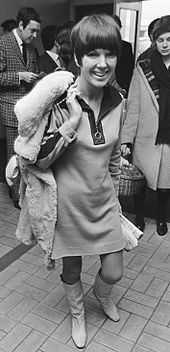Mary Quant
Dame Barbara Mary Quant , DBE (born February 11, 1934 in Blackheath , Kent , England ) is a British fashion designer who is considered the inventor of the miniskirt .
Life
Quant's parents were teachers in Wales, and Quant was studying to be an art teacher at Goldsmith's College of Art . She also learned to design patterns and then worked for the milliner Erik . In 1955 she opened together with her future husband Alexander Plunket Greene (1932-1990) and a friend, Archie McNair, the boutique Bazaar in Markham House on King's Road , in the London borough of Chelsea . She not only sold clothes, she soon designed her own models. A second boutique was opened in Knightsbridge. In 1963 she launched a cheaper secondary brand, Ginger Group . At that time she also designed clothes for JC Penney , the largest chain of stores in the USA.
The miniskirt is considered to be Quant's most important creation, but John Bates and André Courrèges are also among its inventors . The invention of the matching patterned and colored tights (tights) make their John Bates and Cristóbal Balenciaga dispute. Quant reportedly named the Mini after the car . She also created a raincoat and flat boots made of PVC , a material that until then had only been used as a floor covering or tablecloth. Her PVC fashion, the Wet Collection , was featured in her first Paris show in 1963. In 1965, Quant started their first two-week tour of America, during which their models demonstrated their fashion in twelve cities. 1966 she was Queen Elizabeth II. The Order of the British Empire awarded the Officer level. With the Queen 's New Years list , she was named Dame Commander (DBE) in 2015 .
The model Twiggy made the Mary Quant look the late 1960s, the hallmark of a generation. She created a new, child-like type of woman with her extreme figure and a geometrically smooth hair-dryer.
In 2000, Quant withdrew from the fashion business, the company Mary Quant Ltd. was taken over by Japanese owners.
In 1974 the London Museum showed the retrospective Mary Quant's London .
Works
Perfumes
- 1966: Mary Quant
- 1974: Havoc
Dolls
- 1973: Daisy
Fonts
- Quant by quant. Putnam, 1966. Reprinted by Cedric Chivers, Bath 1974.
- Color by Quant. 1984.
- Quant on makeup. 1986.
- Classic Make-up and Beauty Book. 1999.
- Mary Quant: Autobiography. 2011.
Awards
- 1963: Dress of the Year Award
- 1966: Officer of the Order of the British Empire (OBE)
- 1990: Hall of Fame Award from the British Fashion Council
- 2006: Honorary Doctorate from Heriot-Watt University
- 2015: Dame Commander of the Order of the British Empire (DBE)
- Chartered Society of Designers (CSD)
- Royal Designers for Industry (RDI)
literature
- Mary Quant's London. HM Stationery Off., London 1973. Catalog of the clothes in the Mary Quant's London exhibition at the London Museum, Kensington Palace, November 29, 1973–30. June 1974. The London Museum collection is now part of the Museum of London on the Barbican Estate in the City of London .
- NJ Stevenson: The History of Fashion. Styles, trends and stars. Haupt, Bern et al. 2011, ISBN 978-3-258-60032-1 , pp. 176-179.
Web links
- Mary Quant in the Internet Movie Database (English)
- Alfons Kaiser / FAZ: A brief thought (February 11, 2014)
Individual evidence
| personal data | |
|---|---|
| SURNAME | Quant, Mary |
| ALTERNATIVE NAMES | Quant, Barbara Mary (maiden name) |
| BRIEF DESCRIPTION | British fashion designer, is considered the inventor of the mini skirt |
| DATE OF BIRTH | February 11, 1934 |
| PLACE OF BIRTH | Blackheath , Kent |
